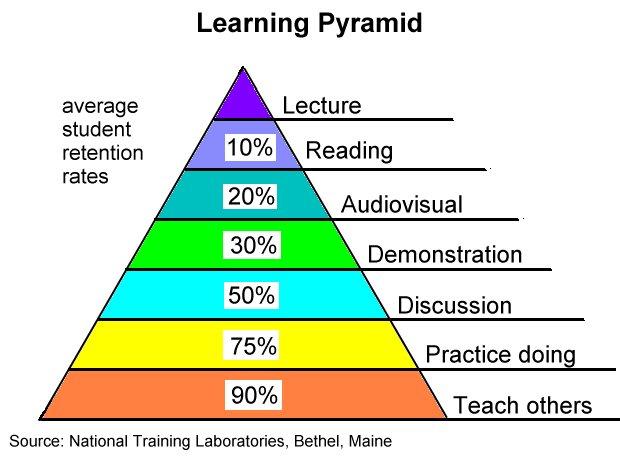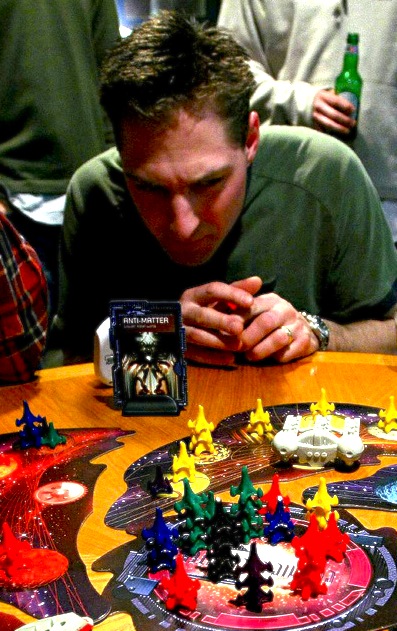Gamified Education Is a New Model of Learning
Critics of gamified education always seem to miss some major points:
1) Gamified education is much more than making mundane activities like work and study fun
2) What makes a game fun is constant learning
3) Not all gamified activities are fun, but they’re engaging
4) Gamified education is the best way to leverage our new technologies to gain the necessary skills and knowledge in the information age
Gamified education should be advocated for its most practical reason: It’s the best method we know on how to organize learning environments to increase knowledge in both diversity and density. Gamified education is not merely an improvement from the current traditional educational model; it’s a completely new innovative way of learning. The traditional educational model is passive and linear; the student sits in a desk to listen a lecture or reads a book. Gamified education is action based and nonlinear, this is significant in many deep levels.
There are two types of knowledge, Explicit and Tacit. Explicit is transferable to other people; this is content like books or lectures. Tacit knowledge is exclusively learned through action and cannot be articulated. You can articulate to someone how to ride a bike, but they won’t be able to operate the bike until they develop their tacit knowledge through trial and error in handling the bike. The development of tacit knowledge is significant in the military and medical fields where training is done through realistic virtual simulations.
But that’s not all, the retention rate of explicit knowledge, which is what traditional education focuses on, increases dramatically through game based learning:

Game based learning isn’t simply about creating an educational video game; it’s about leveraging New Media (blogs, YouTube, search engines) to create a learning community. In the book A New Culture of Learning John Seely Brown and Douglas Thomas give a distinct description on how this is happening with games like World of Warcraft and explain how this method of community building can be leveraged for educational purposes. An example is a project from MIT called Scratch aimed to teach children programming skills. The community is an extension of the main software and turns the platform into a game like experience.
Game designer Raph Koster, author of A Theory of Fun, theorizes that what makes a game fun is the process of constantly learning. When you have a game like platform where knowledge is applied, knowledge becomes a resource. The more you know, the better you are at the game. Many MMO players do mathematical calculations and spreadsheets to improve their performance… for fun! Not only is retention rates of knowledge higher when you immediately apply it in a game, it motivates the students to learn these content and skills in the first place.
The goal of a gamified educational process should be to create a system where improved performance in the game is based on skill (as opposed to time) and that this knowledge is transferable into the real world. But this doesn’t mean that the gathering of explicit knowledge (lectures, books, blogs, etc.) from traditional education is gone. Studies show that in order to become a Grandmaster chess player, deliberate practice and alone study must take place. Geoff Colvin calls this “increasing your map domain” in his book Talent Is Overrated. He also mentions the “multiplier effect” where performing a task (tacit knowledge) motivates the student to study harder (explicit knowledge) in order to perform better in that task, giving examples in sports and music.
The chess article mentioned earlier explains that play alone is not enough to create expertise, but that deliberate practice is the key activity for acquisition of expertise. They define deliberate practice as “appropriately challenging task that are chosen with the goal to improve a particular skill.” This is linked to the game concept of flow, and even though the activity is not fun, it’s highly engaging, which I argue is still gamification. Gamified learning seems to create an intrinsic motivation for new acquisition of knowledge which motivates the players to constantly learn.
In my opinion, gamified education should work as a holistic loop between personal study, New Media-based learning communities and game-based platforms for play. The variation of time between these activities must depend on what is being learned. Chess is stable and the rules don’t change, so improvement in performance over time is maximized through alone study and less play. Play though, is the best way to learn enormous amounts of new content. Playing is children’s way of learning these enormous amounts of new content, and in a world of constant change play based learning is our best tool to absorb and understand all the new knowledge around us in the information age.
CC Image by Phil Romans









I agree with much of what you say here, but be wary of the Learning Pyramid: http://wapo.st/186S95T
You’re thinking! I would like you to invite you to slightly change the context from that image: The learning pyramid doesn’t reflect an exact quantified measure of memorized material applicable to all people, but its more of a reference point.
Example: With demostration the students brains will activate what is called “mirror neurons” and engrain the feedback in the brain deeper then from reading or lecture.
With discussion you don’t just memorize content, but you understand the different contexts behind the content. You get to understand were an idea comes from, what’s going in the mind of the mentor. You also get feedback if you’re missunderstanding a point.
Practice doing builds a fatty sheath called myelin in your brain that helps preserve the neurological networks formed, thus maintaining the knowledge/skill. http://thetalentcode.com/myeli…
Teaching others helps you structure the content in your brain, and understand the subject in a deeper level.
There’s also other variables like “working memory” http://msutoday.msu.edu/news/2…
I agree with what your article that saying, quantifying the pyramid as an absolute is pointles, but there is a lot of empirical research showing that there is validity in how it structures its activity, even though variables will bring different results for different individuals.
Thanks for commenting!
Hello, I am new in the concept of gamification however i find it fascinating. I think you are an expert on the concept and the way you talk about it its awesome. Gamification sounds as the future model for education in different fields, however i have concerns about how people can really transfer knowledge learned from simulations and games to realistic situations. Through my personal experienced i have found that people usually lack of the ability to interconnect concepts and integrate knowledge from differents fields. People use to develop an static model and once one or few variables change their mental model will fall into pieces being unable to respond effectively to a dynamic environment. In your opinion how gamification can deal with restricted minds incapable of finding interactions and relationships between different variables and knowledge, how gamification can assure that people once are out of the simulation will have a high level of responsiveness and performance?
Hi Mark, I’ll divide your post and try to answer in chunks:
“however i have concerns about how people can really transfer knowledge
learned from simulations and games to realistic situations.”
In Knowledge Management there’s two terms taken from biology: Exaptation and adaptation.
Exaptation is when you use something originally intended for one purpose and used for something else. Evolution is filled with examples. This is actually key for innovation, its used by Apple in many of their breakthroughs. In Simulations there’s examples of playing video games in gamecube improving a surges ability in the operating table, or peoples reaction skills while driving. The skills gained in the game serve for different real world purposes.
Adaptation is developing a whole new process for a specific function. Example of this is realistic simulations used in the military and medicine. Instead of practicing with a real plane, pilots use realistic simulations.
Both of these techniques build changes the brain and builds talent in a way that can’t be achieved by reading or listening to a lecture. They build a fatty sheath called myelin: http://thetalentcode.com/myelin/
Lastly, there’s a huge impact in the tacit level. Quick quote:
“While tacit knowledge can be possessed by itself, explicit knowledge must rely on being tacitly understood and applied. Hence all knowledge is either tacit or rooted on tacit knowledge. A wholly explicit knowledge is unthinkable.” Michael Polanyl, book “knowing and being”
This means you can never really understand a subject merely by reading or hearing about it. You must experience it somehow. Just like myelin building, this requires taking action. An example of games aiding explicit studies is given by Gabe Zichermann: He explains he never really understood history until he played the game Civilization, since after playing he understood motives of war, diplomacy, etc.
“Through my personal experienced i have found that people usually lack of
the ability to interconnect concepts and integrate knowledge from
differents fields. People use to develop an static model and once one or
few variables change their mental model will fall into pieces being
unable to respond effectively to a dynamic environment.”
There used to be a logical reason for this: It takes decades to be aware of even one field of knowledge so people compartmentalized field domains. This is changing with the rise of “Complexity Science.” Here’s a brief intellectual history: https://www.youtube.com/watch?v=nJmGrNdJ5Gw
But you’re right, modern problems needs cross-pollination between different fields.
“In your opinion how gamification can deal with restricted minds
incapable of finding interactions and relationships between different
variables and knowledge”
Games help you see the interrelationships between different events. John Hunter has a game called World Peace that teaches students these interconnections: http://www.ted.com/talks/john_hunter_on_the_world_peace_game.html
The world now needs what’s called in Knowledge Management “ecologists” who can see how everything is interconnected, and how making one small change affects everything. People tend to assume that one change in the real world won’t affect other areas, in games you can see in real time how these changes affect the entire ecology of the game.
I also believe Narratives have a huge impact (which is a key feature in games and I believe will begin to be applied in gamification soon). Get you Hands on the book Grand Strategies by Charles Hill.
“how gamification can assure that people once are out of the simulation will have a high level of responsiveness and performance?”
In Biology animals play games to improve their survival skills in the real world. Nature made games fun because its helping you for real world skills as an adult. Games are at their core about problem solving and our brains are hardwired to solve problems in very similar ways we play games. But ofcourse you must understand the right context, some simulations won’t give the real world results due to bad design or incorrect causality. IBM did a study on how playing World of Warcraft improved their staffs management performance: http://www.ibm.com/ibm/gio/us/en/gaming.html
Since its tacit its really hard to tell. There’s a lot more to it, education and business hasn’t catched up but the military is really big in simulations.
Good Questions!
As a teacher I could recommend business simulation game http://virtonomics.com/ -i ncludes most of above mentioned features.